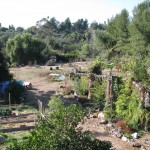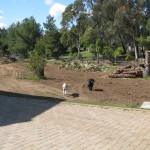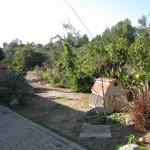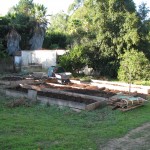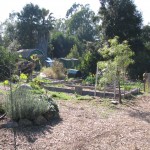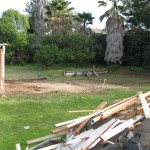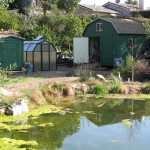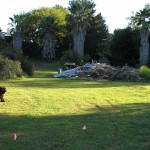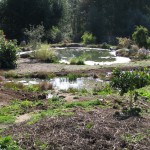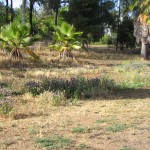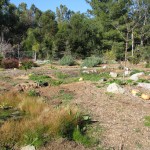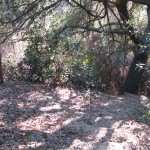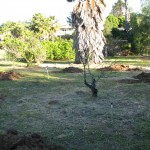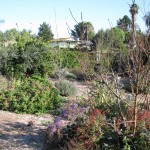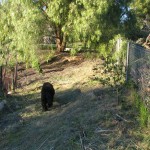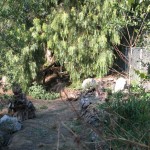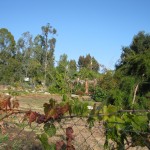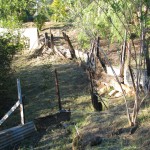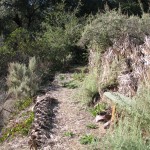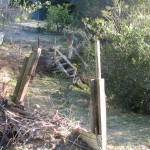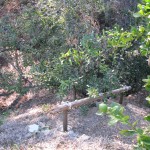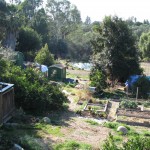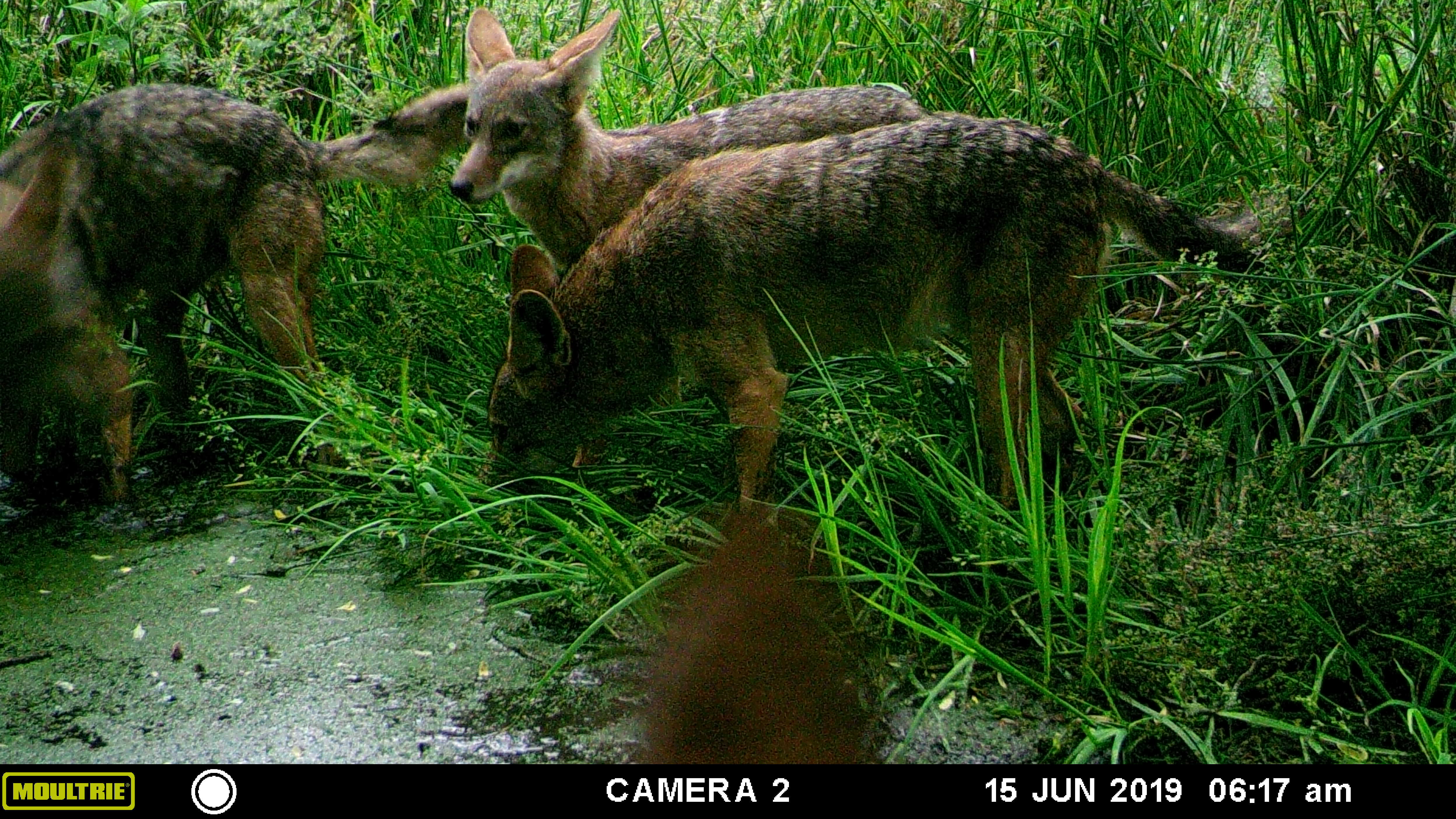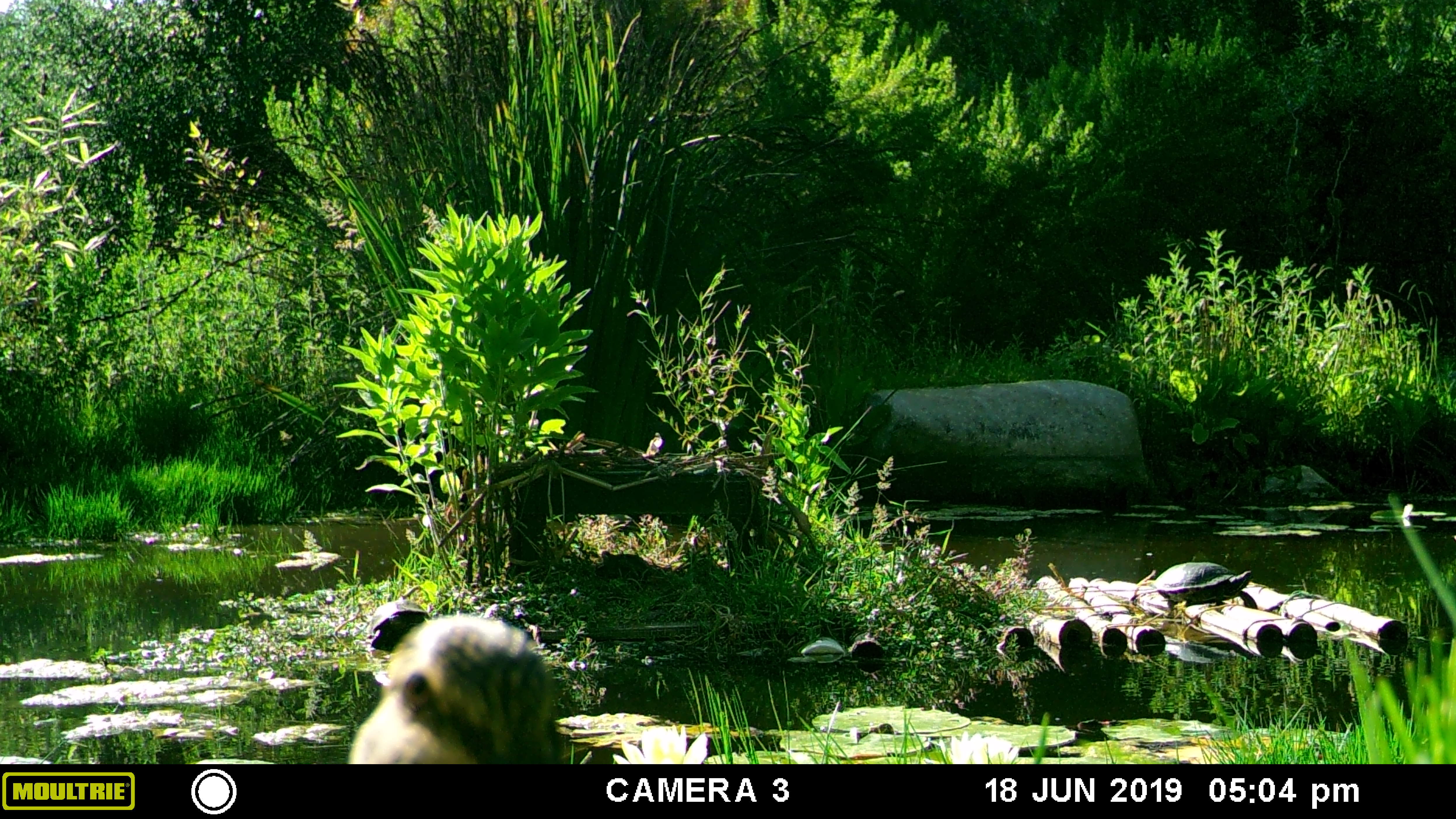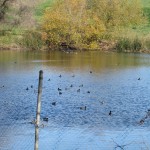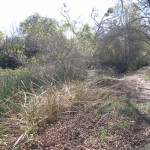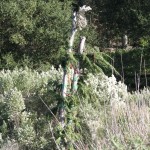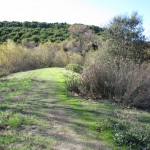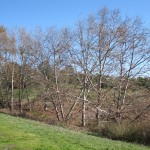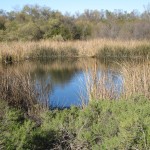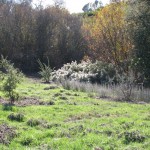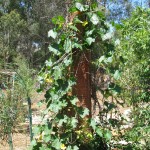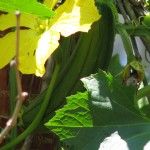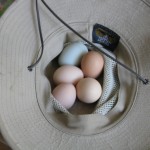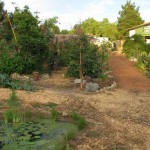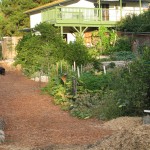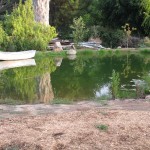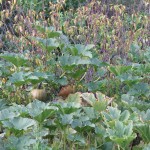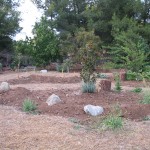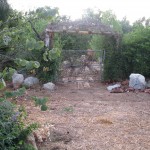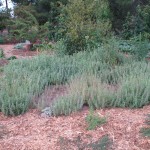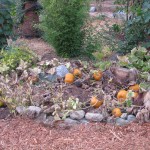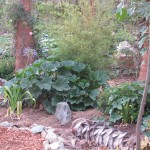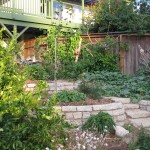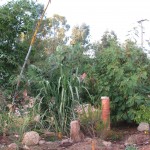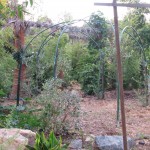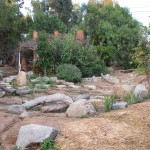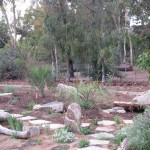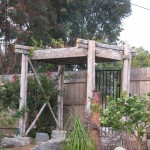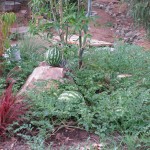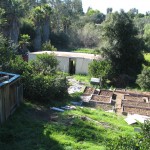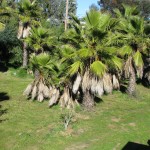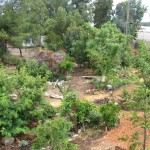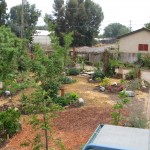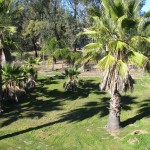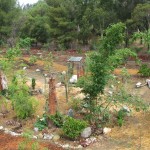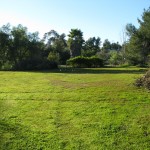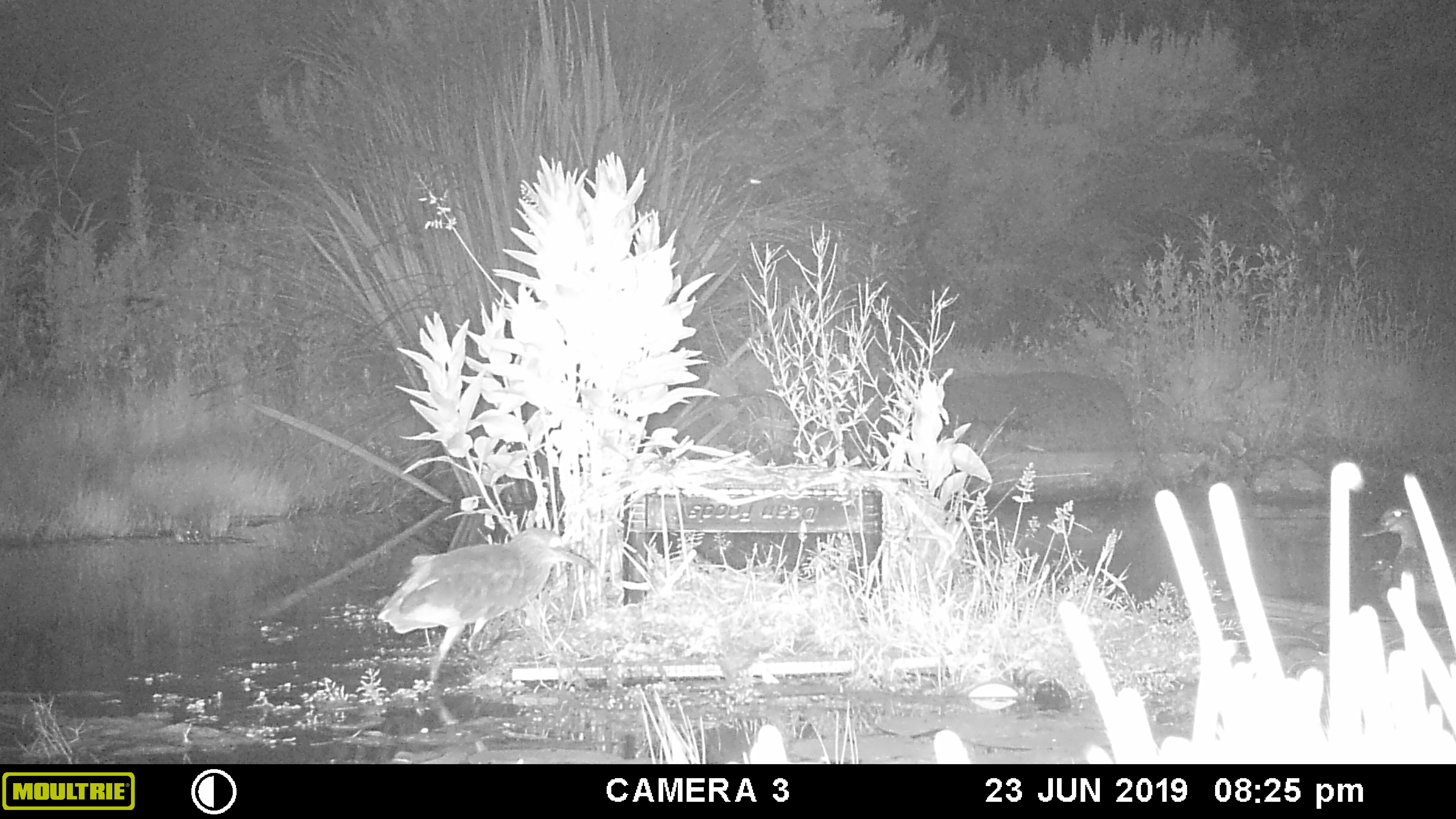- Animals, Bees, Birding, Chickens, Gardening adventures, Heirloom Plants, Other Insects, Permaculture and Edible Forest Gardening Adventures, Photos, Ponds, Rain Catching, Vegan, Vegetables, Vegetarian
Garden’s One Year Anniversary
Happy Anniversary! One year ago on Feb. 1, 2011, I signed a contract with landscape architect Roger Boddaert (760-728-4297) to create a permaculture garden. For twelve years I’ve had this sloping property that was covered in weeds and worthless Washingtonia palms. Not only do these 2 acres slope down to a barranca, but it was filled in due to catching all the rainwater that runs from the street and properties above. I have to give credit to friend Gary B., who brought up the subject of permaculture in a conversation the year before. I’d heard the term and thought I knew what it was about, but months later when I was researching what to do with my property I remembered him mentioning it, and looked it up. I found what I was looking for. I’ve been an organic gardener for many years, have owned chickens for their eggs, have refused to till the soil so as not to kill microbes, have worked naturally with animals and plants, have created habitat, composted, recycled, collected rainwater… and all of that was permaculture. And so much more. How can one not be attracted to the term Food Forest? Certainly not a foodie and gardener like myself.
What happened on the property starting the week of Feb. 1 for the next six months altered the land so that it is truly two acres of habitat. It is useful, it is natural, and it is beautiful. Roger’s team led by Juan built beautiful walls of urbanite, planted and hauled, worked in scorching sun and frosty mornings and made what was dreamed into reality. An integral part of the garden has been diverting the water from erosion points and into rain catchment basins and natural ponds, and that is where Aart DeVos and Jacob Hatch of Aquascape (760-917-7457) came in. They also installed the irrigation. Dan Barnes did the rough and the precise tractor work (760-731-0985) and I can’t recommend his experience and skill enough. Fain Drilling dug the well (760-522-7419) and the wonderful sheds were built by Quality Sheds of Menifee (http://www.socalsheds.com) .
Along with some volunteer help from Jacob, I am the sole caretaker of the property. I am planning the plant guilds, weeding, improving soil, moving problem plants and trees and, did I mention, weed? Oh yes, then there is weeding. On Saturday May 12th, the garden will be on the Garden Tour of the Association of University Women of Fallbrook, and hopefully many people will be inspired to go organic, to create habitat, conserve water and grow extra food for the Fallbrook Food Pantry. We’ve come a long way, baby!
The following photos are comparisons between the precise location last year at this time, and today.
The property last February. The property today. Sophie and General loved all the excitement. They love the new gardens and pond even more. My veggie beds with the old sheds behind. My veggie beds with the new sheds and greenhouse behind. Where the big sheds were: everything usable was reused. New sheds that aren’t a safety hazard, and the greenhouse. The lower area with shed debris (lots of mowing area!). Hey, there are ponds there now! Not much for the neighbors to look at. Quite a lot for the neighbors to look at! Access to the old oak was hazardous. Palm stairs lead past the oak to a birding area. Stonefruit were old when I moved in. New stonefruit adorn what is now the Bee Garden. An erosion area sloping down to the barranca. Water won’t flow through here anymore. Lots of mowing and palm frond removal. Not so anymore. Horrible looking debris failed to hold back the embankment. Palms were used to stabilize the new paths and camoflage the supports. Old unstable stairs led to washout areas. New railings, stairs and urbanite retaining walls lead to another viewing area. The view from my balcony. Part of the old shed remains. Hey, there’s a pond there! -
Re-Ponding, Part 3

Filling it up (that's a hummingbird decal on the window, not a giant hummer!) Just in case you are breathlessly awaiting the next installment of the re-ponding project, I’ll alleviate the suspense. The pond is now shaped as I would like it, with a nice flat shallow end towards the back and a kidney shape. Later I’ll add more contours around the edge so that the parts aren’t rounded; that will not only give it a pleasant shape, but give it more edge, which is much safer for the survival of tadpoles.
By cutting into the irrigation, the pond can be fed with well water instead of domestic water which is not only less expensive, but much healthier. Allowing the water to run down the sides and kneading the clay by hand washes the fine clay particles into the pond. There they can settle and seal the sides.

There is lots of clay in this soil! Every few hours I stirred the pond so as to stir up more clay and have it resettle on the sides.
Now I’m allowing the water level to go down to see if any part of the pond has sealed yet. When the water stops disappearing, I’ll know the bottom and some of the sides are already sealed. This cold weather has made me a little hesitant to be working in the water… brrr! Because of that the pond will probably not be done this week, but I’m working on it.

Stirring up the reddish clay. If sealing the sides with clay in this manner doesn’t work, then I’ll need to separate clay out by hand and mash it onto the sides, kind of like making pottery. That will definitely have to wait until later this week when the daytime temperature rises! Meanwhile as the water sinks, I’m weeding, transplanting, weeding, composting, hauling, and did I mention weeding?
-
Re-ponding, part two

About another foot and a half down for the shallow end. After much hauling of slime water, I finished emptying the pond. Amazingly there were thin red worms living in the gravel and muck in the water! Significant parts of the decomposition process, I’m sure.
Then the pond liner was pulled up (Jacob doing most of the pulling), and below it was carpeting that I’d forgotten I’d put down to cushion the pond liner. The brown carpet was remnants of what had been in the house… memories! Roots from the pine and the palm trees were grown through the carpet, holding it down.

Carpet and sand under the liner. After removing the carpet, we chopped roots and started digging the shallow end. It has to be much lower than the lowest part of the pond, and since that is the high end, there is a ways to go. No guessing what my weekend will be like! There are pockets of hardpacked decomposed granite and masses of roots to be chopped through. We capped old PVC pipe that I found so that it wouldn’t conduct the water out of the pond.

Masses of roots held the carpet together Today the birds were looking for the bird bath and dripper, and yet enjoying searching through the disturbed earth for edible treasures. The egret flew in and stood in the shallow bird bath, dismally looking at the place where the pond had been.
After digging to the right depth, and creating a shape which allows more edge for habitat, the pond will be tested for clay content and then we’ll know how much clay needs to be hauled up from the deposits down below to seal the pond. From what my shovel and my back tell me, it shouldn’t be much!
-
Re-Ponding: Changing a lined pond into a natural pond

Draining the pond with a hose syphon. The little upper pond which my daughter and I laboriously created about seven years ago has finally come to the end of its life. Home to dragonflies, mosquito fish, snails, and some interesting black flatworms, and having provided habitat for snakes, birds, mice and frogs, this lined pond has been beautiful and most satisfactory. Having been given the black flexible pond liner sheet, a lot of very heavy flagstone and some stones, we had cut down a juniper, dug out the roots in heavy clay and rocks, shaped the earth into ledges for nursery pots of waterlilies, and leveled the edges. Everything I read about ponds said to put gravel into it, so against my better judgement I did, and immediately regretted it. The gravel prevented me from walking barefoot in the pond, was a danger to the liner, made walking on the ledges in boots very slippery, and has trapped sediment and roots (end of anti-gravel rant). The pond was aerated by a series of very expensive pond pumps, which trickled water down a little waterfall and impacted my electric bill. This pond was a maintenance problem; I would pull out the algae (carefully picking through it to save trapped fish, snails and dragonfly larvae), but the waterlilies got the better of me. I had no idea that they would grow so huge and disgusting underwater. (See my post The Monster in the Pond, March 2, 2010.) Anyway, after the last pump died this summer, and after the enormous success of the two natural, unlined ponds Aquascape created for my permaculture gardens, I decided that I would change this pond into a natural one.
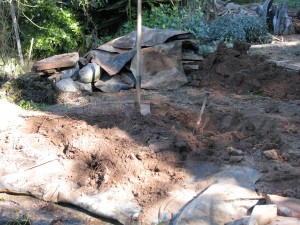
Digging a shallow end for the pond. This area is also the one in which we do our Project FeederWatch bird count for Cornell (http://www.birds.cornell.edu/pfw/), and was our original National Wildlife Foundation Wildlife Habitat (http://www.nwf.org/At-Home.aspx ), which now has extended to our entire property. I wanted a shallow end to the pond with planted waterplants that would clean the water and provide shallow habitat for all the Pacific chorus frogs that come up in late January to breed in the pond. In fact, they’ve been croaking their way up the property already, so now I’m in a rush to get the pond finished for them.

The liner was covered with a mat of plant roots and gravel. Once again I found myself moving large pieces of flagstone and rocks, although I’m seven years older than I was last time, and my back let me know it. Then began the draining of the pond. I tried to start a syphon the way I do to clean my fishtank, by sucking air through a hose and very, very quickly dropping it before I sample the water. I couldn’t get it started. I did get an interesting circular red mark on my lips, which I had to explain that afternoon at my dentist appointment. The difference in elevation between the top and bottom of the hose was not great enough, even though we put together all our hoses and strung them out down the property. I tried to fill the hose with water, but it didn’t work. A phone call to the pond expert, Jacob from Aquascape, made me slap my head with an exclaimed, “Duh!” He recommended attaching the hose to a spigot, sending water through to the pond to fill the hose, then removing the end from the spigot. The water would flow back and the vacuum would start the syphon. Probably everyone in the world knows this, and I knew there was something about attaching a hose that I should do, but couldn’t figure out. Anyway, it worked, but the syphon was a trickle. After many starts and stops, and running back and forth up and down the property, my daughter and I discovered in the morning that the syphon had worked, and almost a quarter of the water had drained. I kept restarting the syphon, until only about a quarter of the water was left. The aroma of the sludgy water infiltrated the house and the yard. I made a fire in the fireplace figuring that for once the smoke was a good thing!

The monster in the pond, revisited. My dear daughter, before returning to college, tackled that monster in the pond. The waterlily was so huge and slippery that she managed to break pieces off but not pull the whole thing out; in fact, she was in danger of being pulled in by it!

Saving water lily chunks to make new plants. Today, with Jacob’s help (actually, he did most of it!), we pulled all the lilies out of the pond. The root systems of the three, which had outgrown their meager nursery containers years ago, just about filled the bottom of the pond. I scraped gravel up with my rubber-gloved hands and then began scooping the remaining water and sludge out with a bucket.

An egret looks hopefully into the sludge. I threw the water onto the plants, and then when the sludge of decayed algae, plant material and soil became thick, I poured it over my bulb beds as a fertilizer. There may be a high concentration of salts in the muck, but the nutrition value should be wonderful. And it makes the ground around my bulbs a lovely black color!

Sludge makes good fertilizer! I almost finished, half-bucketful at a time, hauling water up and out of the pond and onto various areas of the garden, and indeed I meant to finish.

Scooping sludge into a bucket. But with about an inch or more of sludge to go, with yet more gravel to scoop, my body said, “Nope! You’re done!” I also had missed breakfast and had only snacked today, and had been exercising, hiking, planting and weeding for the last few days so I told my self that I had a decent excuse to stop. I took a long hot bath to soak the splashes of yuck off of me, and will continue into the muck and mire tomorrow. Stay tuned!

Our fat cat Pippin, who has nothing to do with this story! -
December in Fallbrook
Coots on the pond Sunlight in the sleeping willows. Tranquility (try not to look at the houses). Tough and determined roots being fed by decaying golden leaves. An impromptu Christmas tree: a snag decorated with juniper, cranberries and bird seed. Lush green weeds keeping a low profile in the winter. Stately sycamores; their leaves shed to keep their roots warm. A season of greens, golds and blues. Coyote bush seed fluff glowing white instead of snow. -
Rain
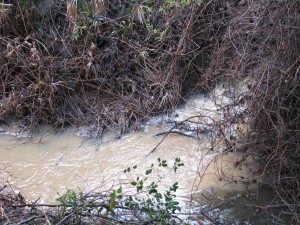
Runoff An interesting fact, especially for those of us in low-rain areas: An inch of pH neutral, nutrient-freeing, perfect rain falling on one acre of land is the equivelent of 27,154 gallons of water. Yep. Where does it go? For most people, it runs off into the storm drains and eventually to the ocean where it becomes salty and unusable without treatment. Then a couple of weeks later, on come the sprinklers delivering not-so-good quality expensive domestic water, further locking up the nutrients and killing the microbes in the soil. How can you capture that wonderful resource of natural rainwater? Water barrels are alittle help, but mostly what you need to do is shape your soil to catch the runoff. Swales, deep loam, and strategic planting can quickly take all that water… even the amount that pours off of your roof, and capture it in the soil. The water slowly sinks and moves the way it was going before, but without taking the topsoil with it. As it moves, the plant roots absorb it over a long period of time, along with all the nutrients that pH-neutral rainwater has freed up in the soil. Your landscape will be stunning, your water bill can eventually be reduced to zero, and if you grow food plants, the nutrition level in them will rise. Here is a video from permaculturalist Geoff Lawton with graphics: http://www.youtube.com/watch?v=UFeylOa_S4c.
This is the essence of permaculture. Simple, logical effort to use what we already have to return the soil to the sponge it was before we compacted it. So how large is your plot of land? Nine acres? A back porch with pots? You can still do the math and see how much water you can capture. Look up rainwater harvesting videos on YouTube and see plots of land in the desert that harvest rainwater and are oasises of food, habitat and beauty, without supplemental water. Here is what Lawton has done with ten acres in Jordan: http://www.youtube.com/watch?v=xvmx4lcqQVw. If they can do it on that scale in that poor an area, any homeowner can do it.
- Gardening adventures, Permaculture and Edible Forest Gardening Adventures, Photos, Ponds, Rain Catching
The October Garden
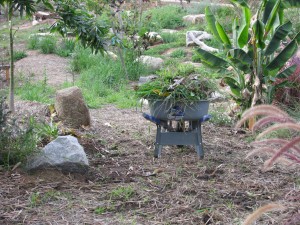
Weeding The weeds took advantage of the warm weather and my absence last week to really get some growing in. I’m pulling each weed by hand, shaking off the dirt (trying not to get showered with it in my eye), and composting them. The greens when layered with brown material (dead clippings, etc.) will cook nicely for use next year. I have a tall wire cage set up in one of the raised beds I haven’t filled yet, so the compost will be made right where it will be used.
Meanwhile the garden grows. Melon vines are dying, but the squash continues on!

Luffa vines grew up the palm trunks, then down again to the ground! With permaculture the idea is to mimic a forest dynamic, with lots of plants helping each other grow by providing elements other plants lack, such as nitrogen, mulch, shade, flowers to attract pollinators, etc. You can fit a lot of plants into a small area.
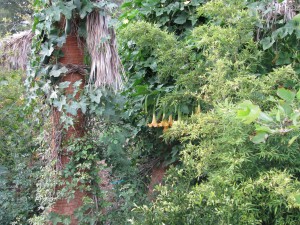
You can fit a lot of plants in a small space with adequate nutrients and water 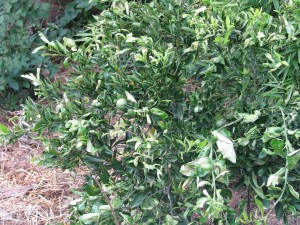
Trouble with citrus The orange tree above is receiving too much irrigation water due to its placement on sloping land and the nearness of water-loving plants. Planning beds with compatible plants providing adequate initial nutrition and water can result in happy masses of plants.

The palm walkway has become a jungle tunnel 
Bamboo and sugarcane 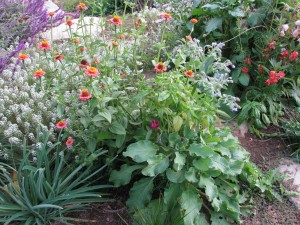
Bee and butterfly seed mix The pond, now six months old, looks as if it has been on the property for years.

The pond looking natural The melon vines and pumpkins have not only protected the land from the scorching summer sun, but will provide good compost and certainly are decorative as well as sources of food. I always wanted to wait for the Great Pumpkin!
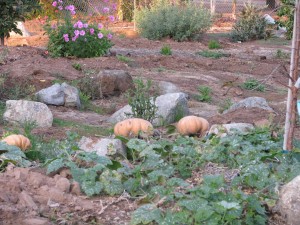
Cinderella pumpkins, with purple cosmos across the dry streambed Sages, mints and butterfly bushes continue to flower, providing much needed pollen sources for bees in this season of dearth.
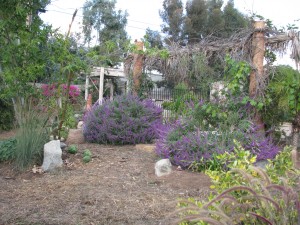
The entranceway 
Bananas and sage Meanwhile in the vegetable garden many crops have had their day and I’m composting them as I get to them. Some such as the eggplant are still going strong. (See my steamed eggplant recipe! Yum!) .

Another giant eggplant hiding in the strawberries A garden as large as this can be overwhelming, especially in its first year. I’m trying to think in sections. I enjoy working the garden, making it mine and seeing the surprises that show up. My back and hands aren’t as happy, especially the morning after, but… too bad! “Get over it, guys!” I say, then realize I’m talking to my body parts. Alone in my garden, only the plants really care, and they aren’t looking. Or are they?
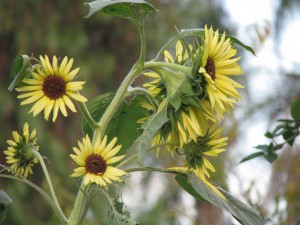
Sunflower keeping an eye out in all directions -
First Rain
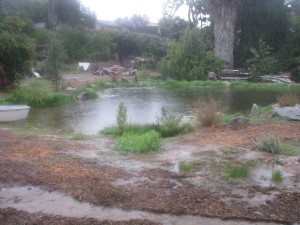
Rainfall on the pond The first week of October and we’re having a day of heavy rain… almost unbelievable. Normally October in San Diego is high fire season. The brush is crisp from months of drought and high temperatures, and then the Santa Ana winds begin: wild dry winds that blow east to west from the deserts, full of static and mad gusts that turn brush fires into firestorms.
My property is a watershed, funneling rainwater from the street through to the streambed in the barranca below, taking all my topsoil and some of the embankment with it. This year I had the beginnings of a permaculture garden installed to remedy this pattern. By deepening the loam and placing berms around plant guilds water is encouraged to pool up and soak in rather than run off. Overflow is channeled through a series of dry ponds which allow water to soak into the ground. From there it is channeled safely down to an overflow into the stream. Today was an early test of what has been worked on since Feb. 1.
The tilling, mulching and berming done by the crew of landscape architect Roger Boddaert proved successful.
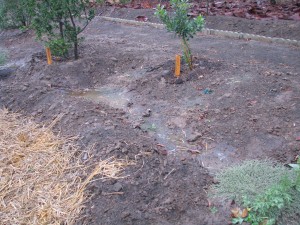
Berms hold water back so that it may soak into the loam The soil has a high clay content, which was good news when digging the large pond because it held water without a liner. It is bad news for other areas of the garden where water is pooling up instead of sinking in. I was able to take note of these areas this afternoon so that they could be drained and mulched for more absorption.
Aquascape, the company that installed the series of ponds, is still planting and maintaining the waterways. Jacob came out in the rain and watched it flow, shaping and fortifying as the force of the rain and thus the volume increased.
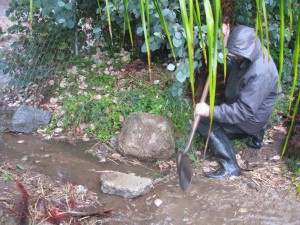
Jacob helping water flow Water flowed under the fence from the street, but instead of flooding a cement culvert as it used to do, it is channeled down to the ponds.
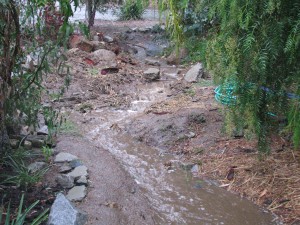
Street run-off enters under the fence 
Blocked by debris, water floods past the bridge Silt and debris blocked water flow under the bridge, and was eroding the area by the structure called the Nest. I cleared the debris and raked rocks and silt to the weak side, and that fixed the problem temporarily.
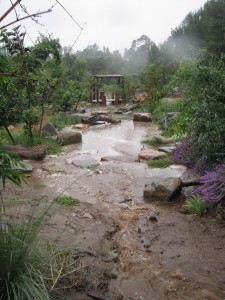
Rainwater flowing into the first 'dry' pond Water quickly filled the first dry pond; with the high clay content, water percolates but does it slowly.
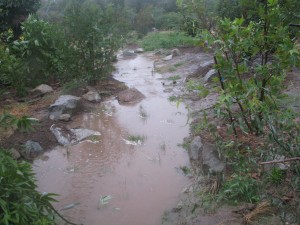
'Dry' ponds filling and slowing run-off 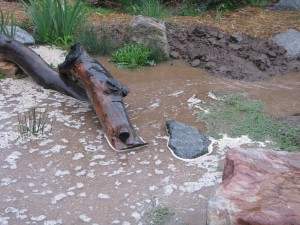
Logs and rocks are ornamental and slow water flow 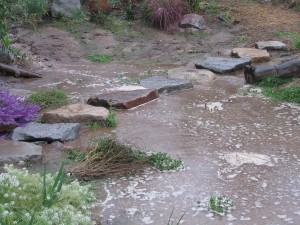
Normally dry, the stone crossing is now almost underwater 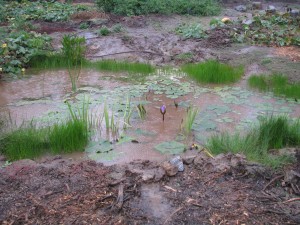
The little pond is rapidly filled. As water reached the small pond, which wasn’t intended to permanently hold water but the clay had a different idea, the sides had to be shored up and the overflow diverted.
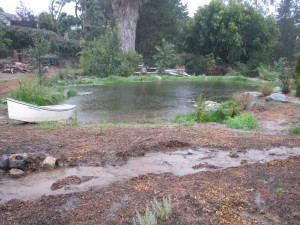
Water is diverted from the little pond around the big one Extra floodwaters aren’t being diverted into the large pond because we don’t want it filled with silt, and we don’t want it overflowing rapidly and eroding the sides. Instead the water flows through a channel around the large pond, then down to a prescribed place to flow out and over the embankment to the stream below.
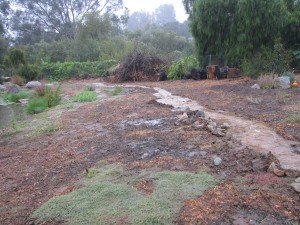
Overflow is channelled past the ponds and out to the natural stream below Some areas of heavy erosion had been filled and supported, and as of six this evening they looked wet but not iffy. What a night of heavy rain will do, I’ll have to see in the morning. I am very lucky to have this type of
rain early in the season. It has been heavy enough to cause significant water flow to help shape the watercourse and show weak spots, and the rain will be reduced to showers tomorrow then clear up, so repairs and improvements can be made before true flooding happens later in the year or early in the next.Although much more water is being held on the property, and topsoil is not being lost, it still pains me to see so much rain channeled out to the stream. Rainwater is a neutral Ph, and carries nitrogen (especially when
there is lightning). It is the best possible water for plants, as well as for human consumption and bathing. In side-by-side comparisons with tap water, plants watered with rainwater flourish far beyond the growth of the others. I’m greedy to hold that water onto my property, letting it soak as deeply as possible for tree roots to use far into the year. As the newly planted trees grow, their roots will help hold water and soil. As their leaves drop the mulch levels will raise, aided by compost and mulch that I will be constantly adding, and the soil will become more absorbent farther down. Each rain should have less runoff and more absorption. This rain has shown a great success with the garden, but I know it is only the beginning. - Chickens, Gardening adventures, Heirloom Plants, Permaculture and Edible Forest Gardening Adventures, Photos, Ponds, Rain Catching, Vegetables, Vegetarian
The August Garden
Plants have been enjoying the beautiful weather and the constant irrigation from the well, and the garden is flourishing. So, unfortunately, is the Bermuda grass, but that is another tale. Since I see it everyday I don’t notice the change so much, but when I show someone around I am thrilled all over again with the incredible change that has happened on this property. There are so many birds, insects, reptiles and other animals either already here or scouting it out that I know the project is a success. It is a habitat, not just for me and my family, but for native flora and fauna as well. It wasn’t so long ago that I had a cracked, weedy asphalt driveway, a termite-ridden rickety porch that needed pest control, a house with a stinky deteriorating carpet and old splotchy paint, a tile kitchen counter with the grout gone in between and a cleaning nightmare, and a yard full of snails, weeds and Washingtonia palm trees, with the embankment eroding each rainfall. Over the last four years we’ve survived some pretty intense construction projects (none of which were done on time, no matter what they promised!). My house still has some repairs that need to be done but I no longer am embarrassed to have anyone over. The garden is wonderful to walk in and explore. I’ve taken some photos this evening to show you how things are growing:
Bees enjoying purple coneflowers The luffa squash has mighty asperations. A luffa squash and bloom. They are edible small and green, but I’ll leave them to dry. Five eggs today! Each laying hen participated for the first time! The little girls have grown up. The small lower pond and the palm pathway. The veggie bed. Rushes, fleabane, waterlilies and other plants are growing in nicely around the big pond. The boat is still on loan from Aquascape. A pumpkin tree? This apricot isn’t healthy, but the pumpkins sure are. These bare areas I’ll fill with plants that will make up guilds, each plant filling a niche to help the others grow. The entrance to the bee garden. Native vinegar weed loves a place we left untouched, and so do the bees. Sugar pumpkins ready a little early for Halloween. A feral zucchini, still producing at least one a day. Melons, passionfruit, pitcher plant and many others under the back porch we call the Poop Deck. Very eager bamboo, sugarcane and hops. Olive trees tied to painted PVC pipe to make a hut. The ‘Nest’ beyond the dry stream bed. A thud and a swish… with no warning the neighbor’s tree fell across the fence. A green roof for the entranceway, just beginning to show. The watermelons in the vegetable beds were tiny… these monsters are wild. That one grew on the rock on its own. Entranceway flower tunnel… with dogs waiting to go inside! -
Midsummer Garden
When I’m in the garden everyday, I find that I forget that only seven months ago, things looked radically different. I’ll post some before and now photos below:
View to pond, before View to veg now Out to neighbors before View to neighbors now Entryway before Entryway now Middle property before Middle property now Lower yard before Lower yard now What a difference six months can make!

